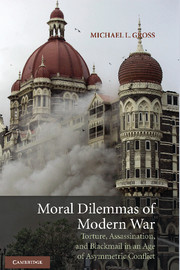Book contents
- Frontmatter
- Contents
- Preface
- List of Abbreviations
- 1 Torture, Assassination, and Blackmail in an Age of Asymmetric Conflict
- 2 Friends, Foes, or Brothers in Arms? The Puzzle of Combatant Equality
- PART I COMBATANTS IN ASYMMETRIC WAR
- 3 Shooting to Kill: The Paradox of Prohibited Weapons
- 4 Shooting to Stun: The Paradox of Nonlethal Warfare
- 5 Murder, Self-Defense, or Execution? The Dilemma of Assassination
- 6 Human Dignity or Human Life: The Dilemmas of Torture and Rendition
- PART II NONCOMBATANTS IN ASYMMETRIC WAR
- PART III CONCLUSION AND AFTER WORD
- Notes
- Selected Bibliography
- Index
4 - Shooting to Stun: The Paradox of Nonlethal Warfare
Published online by Cambridge University Press: 05 June 2012
- Frontmatter
- Contents
- Preface
- List of Abbreviations
- 1 Torture, Assassination, and Blackmail in an Age of Asymmetric Conflict
- 2 Friends, Foes, or Brothers in Arms? The Puzzle of Combatant Equality
- PART I COMBATANTS IN ASYMMETRIC WAR
- 3 Shooting to Kill: The Paradox of Prohibited Weapons
- 4 Shooting to Stun: The Paradox of Nonlethal Warfare
- 5 Murder, Self-Defense, or Execution? The Dilemma of Assassination
- 6 Human Dignity or Human Life: The Dilemmas of Torture and Rendition
- PART II NONCOMBATANTS IN ASYMMETRIC WAR
- PART III CONCLUSION AND AFTER WORD
- Notes
- Selected Bibliography
- Index
Summary
In many instances, our forces are allowed to shoot somebody and kill them, but they're not allowed to use a nonlethal riot-control agent … There are times when the use of nonlethal riot agents is perfectly appropriate, although legal constraints make for a very awkward situation.
Donald Rumsfeld, former U.S. Secretary of DefenseRumsfeld has a point. How can modern war make it easy for soldiers to kill one another with bullets, shells, and bombs but make it hard for them to incapacitate their enemies with chemical or biological agents, sound waves, blinding lights, or electromagnetic pulses? Indeed, it seems paradoxical that international law allows, if not encourages, adversaries to kill one another by the most horrible means imaginable, while forbidding them from employing an array of weapons that will only temporarily disable enemy soldiers.
Nonlethal weapons (NLWs) are not weapons of mass destruction. They are specifically designed to temporarily incapacitate rather than kill. They do not inflict intense suffering. They produce no effects that extend beyond the time of war. Nor do they cause wounds that are especially difficult to treat. They seem, at first glance, to offer means that are both militarily useful and relatively friendly on the battlefield. So, is Rumsfeld right? Should advanced nations embrace nonlethal weaponry to both wage war effectively and reduce its suffering? Taking up Rumsfeld's challenge requires another look at NLWs (especially those he calls “nonlethal riot control agents”), their place in asymmetric warfare, and the arguments of those who oppose them.
- Type
- Chapter
- Information
- Moral Dilemmas of Modern WarTorture, Assassination, and Blackmail in an Age of Asymmetric Conflict, pp. 77 - 99Publisher: Cambridge University PressPrint publication year: 2009



